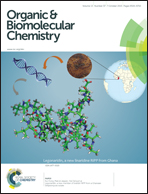Effect of bridgehead substitution in the Grob fragmentation of norbornyl ketones: a new route to substituted halophenols†
Abstract
Grob fragmentation of suitably designed bicyclic species often generates novel organic skeletons in a facile manner. Herein, we report a comprehensive account of an effective acid-catalyzed Grob fragmentation of trihalonorbornyl ketones to dihalophenol derivatives in good yields. The transformation entails tri-n-butyltin hydride (TBTH) mediated regioselective reduction of one of the two bridgehead halogens of readily available Diels–Alder adducts resulting from 1,2,3,4-tetrahalo-5,5-dimethoxycyclopentadiene and vinyl acetate derivatives, followed by its conversion to substituted halophenol species via a three-step hydrolysis–oxidation–rearrangement/aromatization strategy. Both alkyl and aryl substituted norbornyl ketones were studied. A detailed mechanistic analysis employing an isotope labeling experiment revealed plausible mechanistic pathways. Among the two bridgehead substituents, when halogen (X = Cl, Br) stays at C-1 and hydrogen (H, or deuterium, D) at C-4, then product formation takes place via exclusive protonation (supplied by an external acid) at β carbon (i.e. C-1) of a dienol moiety formed in situ during the Grob-fragmentation, followed by the removal of acidic 4-H (or 4-D) and halide ion (X−) from the resulting cyclohexenone intermediate prior to nucleophilic attack on the oxocarbenium ion by X− and final enolisation of cyclohexadienone species. A sharp deviation was observed with the regioisomeric bicyclic ketone, wherein the 4-X triggers a facile removal of X− and forms the end products without necessitating the involvement of the C-1 substituent (i.e. 1-H/D), thereby retaining it in the final halophenols. It clearly demonstrates how the bridgehead substituents in the two regioisomeric trihalo-norbornyl ketones steer the bicyclic systems to follow entirely different reaction pathways thus suggesting their crucial yet distinct roles in the overall reaction. The present transformation thus manifests the relevance of bridgehead substituents in the Grob fragmentation of such norbornyl systems. Our current strategy also allows one to access ortho-deuterated halophenol compounds.


 Please wait while we load your content...
Please wait while we load your content...